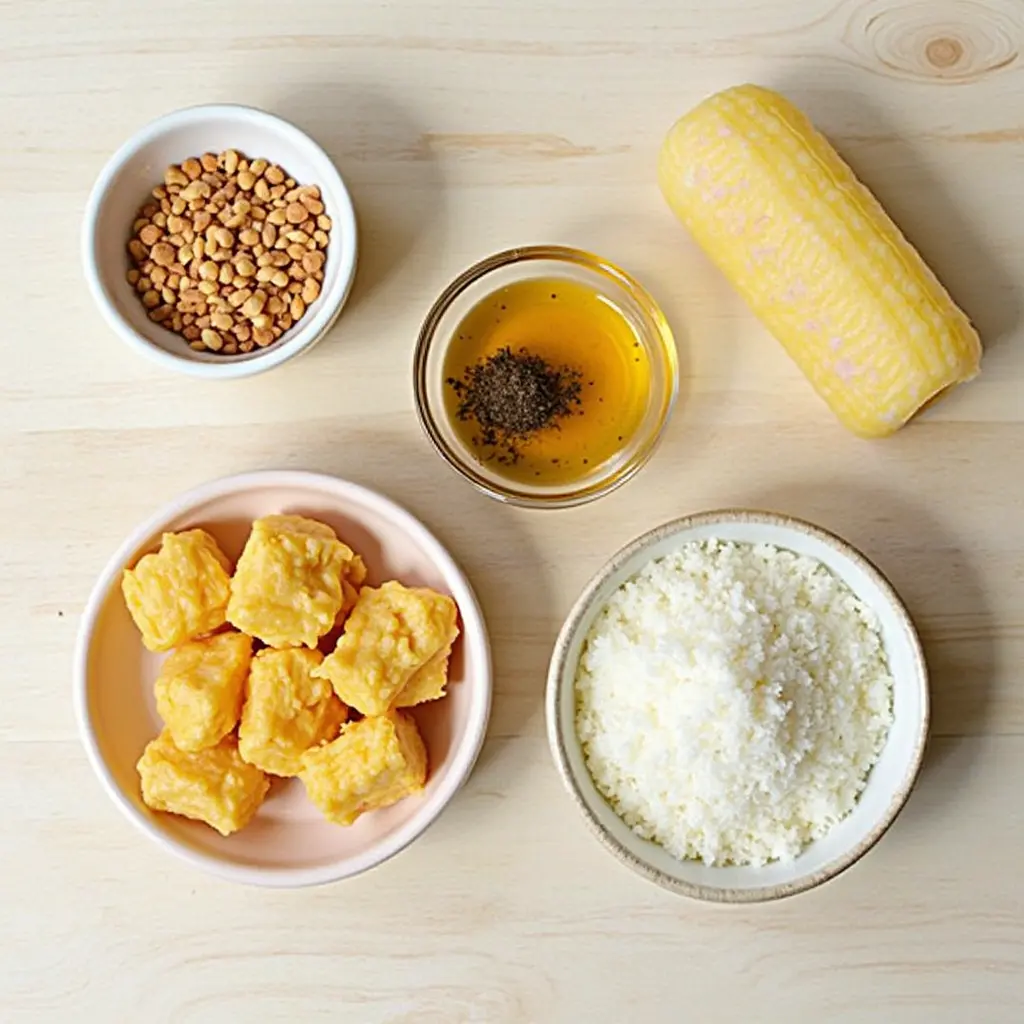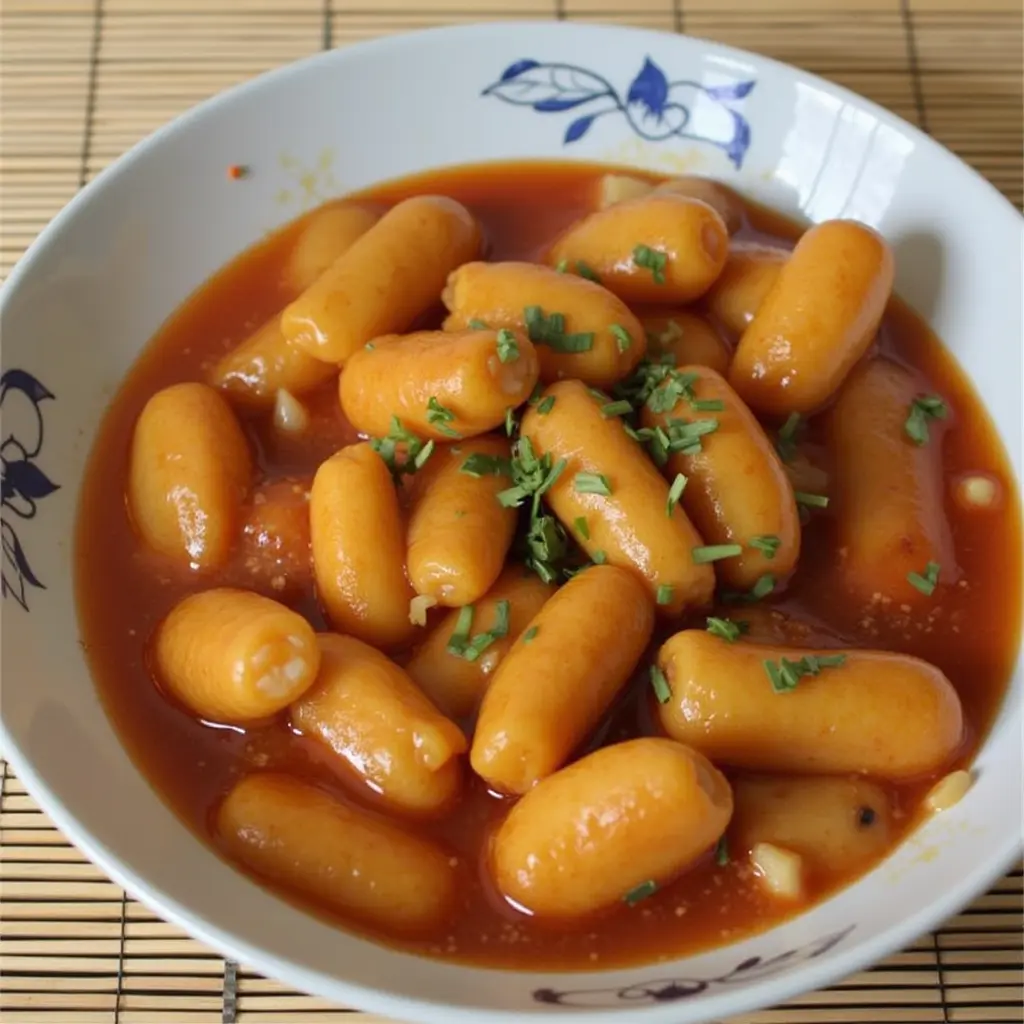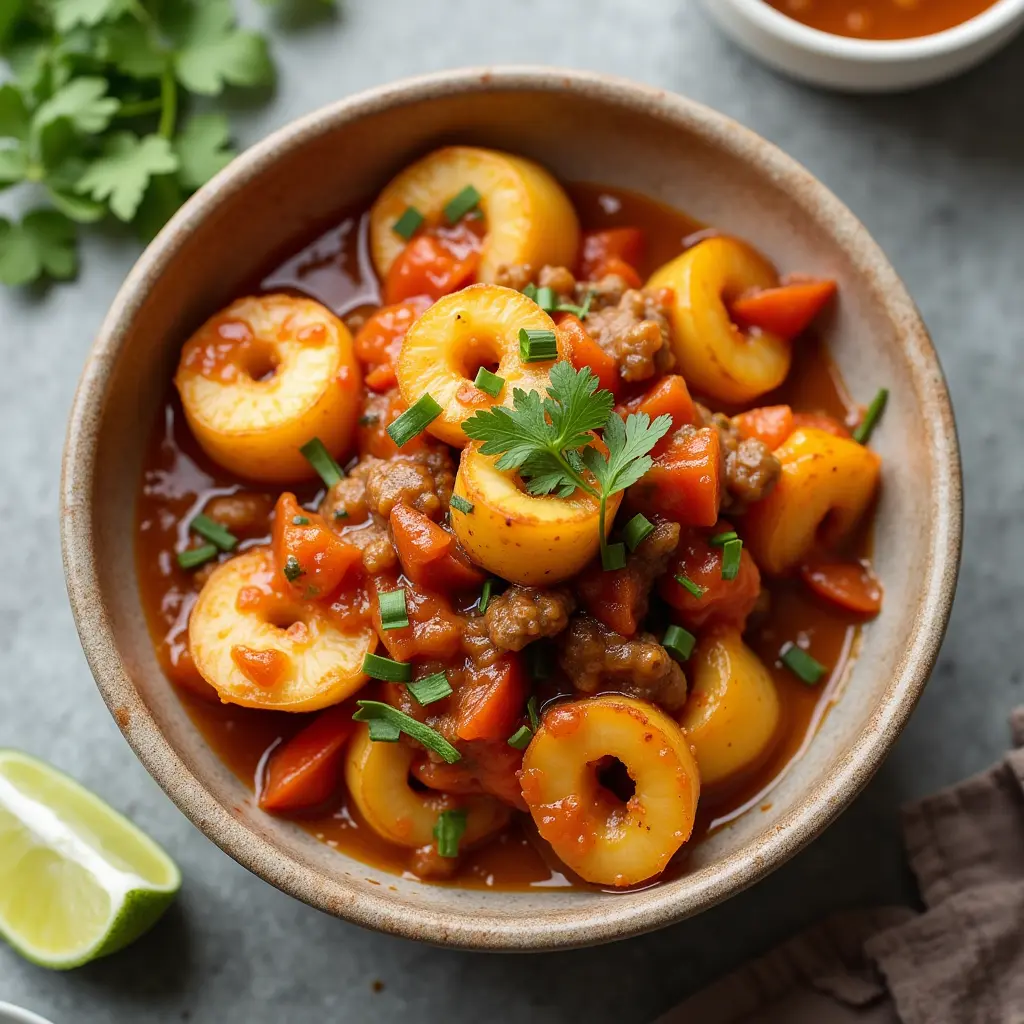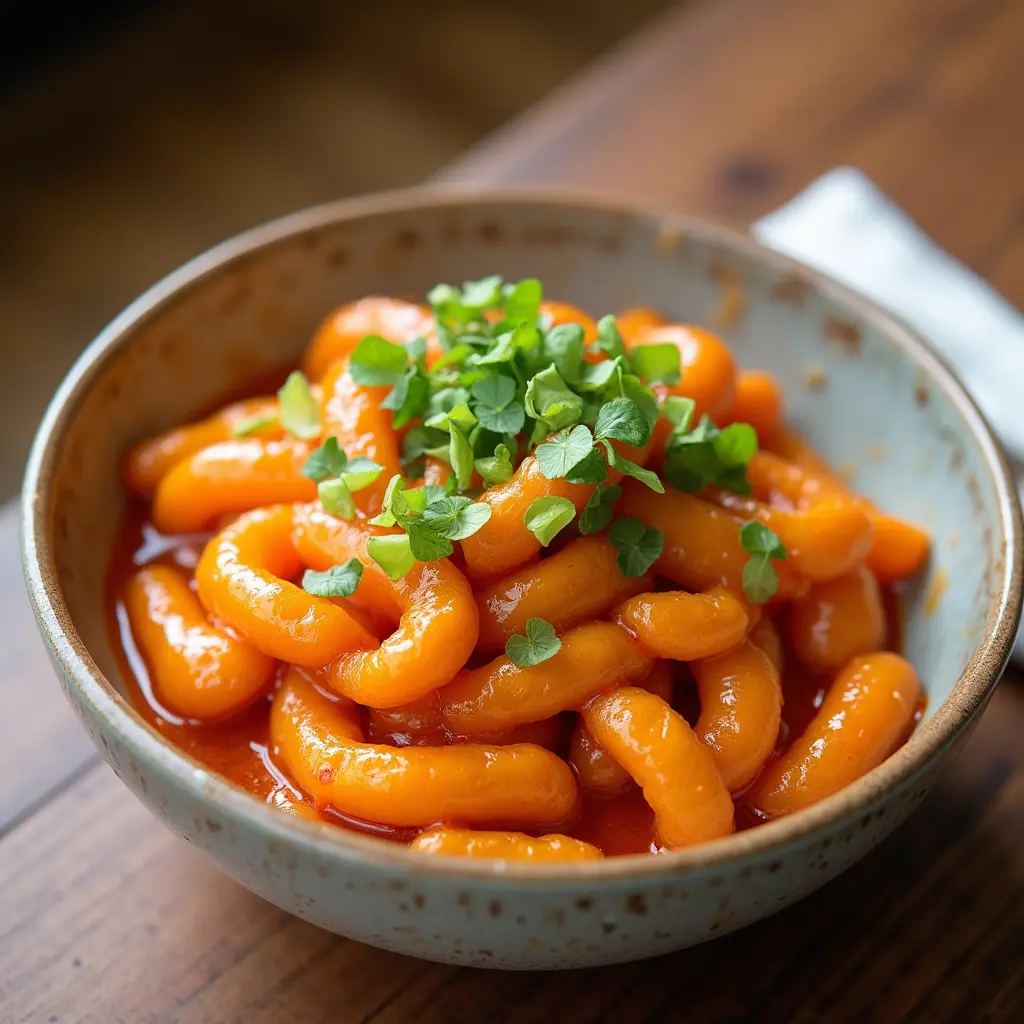Introduction: What is Korean Tteokbokki Made of?
Tteokbokki is a popular and iconic Korean dish known for its sweet, spicy, and savory flavors. This delicious street food consists of chewy rice cakes, called “tteok,” cooked in a flavorful sauce. The base of the sauce is gochujang, a fermented chili paste that gives Tteokbokki its signature heat. It’s often balanced with sweetness from sugar or honey and seasoned with soy sauce, garlic, and sesame oil for added depth.
In addition to rice cakes, Tteokbokki often includes fish cakes (eomuk), boiled eggs, and sometimes vegetables like cabbage and carrots. These ingredients contribute to the dish’s variety of textures and flavors.
There are also different variations of Tteokbokki, such as Rabokki, which combines Tteokbokki with instant ramen noodles, or Cheese Tteokbokki, where melted cheese adds creaminess. Tteokbokki remains a beloved dish in Korea and beyond, enjoyed for its bold and comforting taste.
Understanding Tteokbokki
Tteokbokki is a popular and delicious Korean dish that has become a favorite among food lovers worldwide. So, what is Korean Tteokbokki made of? The dish primarily consists of chewy rice cakes soaked in a spicy-sweet sauce. Tteokbokki originally started as a royal court dish during the Joseon Dynasty and has since evolved into the beloved street food it is today. Although the basic ingredients are simple, the flavor profile is vibrant, making it both comforting and exciting to eat. The rice cakes, known as tteok, form the foundation of the dish, while the signature sauce uses gochujang, a spicy and fermented chili paste that gives the dish its distinctive flavor.
Over time, Tteokbokki has seen many variations, with different regions and restaurants adding their own unique twists. This dish is not only a symbol of Korean street food but also a representation of Korea’s rich culinary culture.
The Key Ingredients of Tteokbokki
Tteokbokki consists of several core components that define its taste and texture. These ingredients work together to create a dish that is both spicy and sweet, savory yet satisfying. Here are the key elements:
- Rice cakes (tteok): These provide the chewy base.
- Gochujang (Korean chili paste): This offers the essential heat.
- Fish cakes (odeng): These add a savory note.
- Broth or stock: This ties everything together.
- Vegetables and garnishes: Ingredients like onions and scallions add freshness and balance.

Each ingredient brings something unique to the table. The rice cakes create the foundation, while the gochujang adds spice. The fish cakes introduce a savory flavor, and the broth blends everything into a harmonious dish. Vegetables enhance the overall freshness and balance.
Tteok (Rice Cakes)
The base of Tteokbokki lies in the rice cakes, known as tteok. Made from glutinous rice flour, these chewy rice cakes have a dense yet soft texture. Cooks boil or simmer the rice cakes in the sauce, allowing them to absorb the flavorful liquid, making each bite a satisfying combination of chewiness and flavor.
Rice cakes come in various sizes and shapes, but the oval or cylindrical ones are most commonly used in Tteokbokki. The texture of the rice cakes sets this dish apart, as they provide a substantial and satisfying bite that perfectly complements the spicy sauce. Without the tteok, Tteokbokki would lose its signature chewiness and texture.
Gochujang (Korean Chili Paste)
One of the key elements of Tteokbokki is gochujang, the iconic Korean chili paste. Cooks make gochujang by fermenting red chili peppers, glutinous rice, fermented soybeans, and salt. This paste gives Tteokbokki its signature deep red color and spicy kick. It perfectly balances heat and sweetness, making Tteokbokki irresistible.
Gochujang provides the spicy base for Tteokbokki’s sauce while also adding a rich umami flavor that enhances the overall taste. Though it’s the main source of heat, the fermentation process gives the paste a savory depth, setting it apart from other chili-based sauces.
Fish Cake (Odeng)
Another important ingredient in Tteokbokki is fish cake, also known as odeng in Korean. Made from fish paste, usually ground white fish, fish cakes are shaped into thin sheets or blocks. Cooks add them to the Tteokbokki mixture, allowing them to simmer in the spicy sauce and absorb the rich flavors.
Adding fish cake brings a savory, mild seafood flavor that complements the heat of the gochujang. Its soft texture and subtle taste allow it to absorb the spicy sauce, enhancing each bite with extra depth.
Broth and Seasoning
The broth or seasoning used in Tteokbokki plays a significant role in determining its flavor. While the key components of the sauce come from gochujang and soy sauce, the broth can vary depending on the recipe. A common base for the broth is anchovy stock, which provides a subtle umami flavor that enhances the overall taste.
TTo prepare the broth, cooks boil water or stock with gochujang, soy sauce, and sugar, creating a rich, spicy, and savory liquid that coats the rice cakes and fish cakes. The sweetness from the sugar balances the heat of the chili paste, resulting in a well-rounded flavor. Seasoning is adjusted to taste, with some variations adding garlic, sesame oil, or other spices to deepen the flavor.
Vegetables and Garnishes
While Tteokbokki can be enjoyed in its simplest form, many recipes include vegetables and garnishes to enhance the dish. Common additions like sliced onions, cabbage, and scallions provide extra textures and offer a refreshing balance to the rich, spicy sauce.
Cooks often top Tteokbokki with a hard-boiled egg, which adds richness to the dish. Some variations also include tempura, which provides a crispy texture that contrasts with the chewy rice cakes.
The Flavor Profile of Tteokbokki
The flavor profile of Tteokbokki combines sweet, spicy, and savory elements. Gochujang provides the primary heat, balanced by sugar and sometimes other sweeteners, which give the dish a slightly sweet undertone. The fish cakes add a savory layer, while the broth ties everything together with an umami richness.
The rice cakes, as the base of the dish, absorb all of these flavors, allowing the chewy texture to carry the sauce and seasonings in every bite. Tteokbokki offers an enticing combination of flavors that keeps you coming back for more, making it the perfect comfort food.
How Tteokbokki is Traditionally Made
it’s important to know the traditional method of preparation. The process begins by simmering rice cakes and fish cakes in a flavorful broth made from gochujang, soy sauce, and sugar. Cooks then combine the ingredients until the rice cakes become tender and absorb the rich, spicy sauce.

Traditionally, cooks prepare the dish over high heat to quickly thicken the sauce, but many modern recipes call for longer cooking times to deepen the flavor. Some cooks also add vegetables and other garnishes toward the end to enhance texture and flavor.
Preparing the Rice Cakes
The preparation of rice cakes is an important part of making Tteokbokki. In most cases, cooks soak dried rice cakes in water for at least 30 minutes before cooking. This step softens the rice cakes, making them tender and ready to absorb the sauce.
After soaking, cooks add the rice cakes to the boiling broth, where they cook until they become soft and chewy. As the sauce simmers, it thickens and coats the rice cakes and fish cakes in a flavorful glaze.
Cooking the Broth
Cooking the broth for Tteokbokki is essential for achieving the dish’s signature taste. The broth starts with water or stock, which is boiled with gochujang, soy sauce, and sugar to create the base sauce. Cooks adjust the seasoning according to personal preferences, with some recipes adding extra spices like garlic or sesame oil.
Once the broth is ready, cooks add the rice cakes and fish cakes, then simmer them together, allowing the ingredients to absorb the flavorful sauce.The key is to cook the dish until the rice cakes are tender and the sauce has thickened, creating a rich, flavorful coating.
Variations of Tteokbokki
While the traditional Tteokbokki recipe remains the most popular, many modern variations have emerged, offering different twists on this classic dish. Some of the most common variations include:
- Spicy Tteokbokki: An extra spicy version with additional chili peppers or more gochujang.
- Creamy Tteokbokki: A fusion version that incorporates a creamy sauce, adding a rich and velvety texture.
- Vegan and Vegetarian Tteokbokki: A plant-based version made without fish cakes and using vegetable-based broths.
Spicy Tteokbokki
Spicy Tteokbokki is the most traditional and popular version of the dish. The dish gets its heat primarily from gochujang, but some recipes may add extra chili flakes or fresh chilies for an even spicier kick. The dish maintains its signature sweet and savory flavor, but the heat is intensified to suit those who love spicy foods.
Creamy Tteokbokki
For those who prefer a milder, richer version, creamy Tteokbokki offers a decadent twist. This variation uses a creamy sauce made with ingredients like cream, milk, or cheese. The creamy base contrasts with the heat of the gochujang, creating a more comforting and indulgent experience. The addition of cheese also adds a layer of richness, making it a favorite for those who enjoy a smoother, less spicy dish. Creamy Tteokbokki has become a popular choice for those seeking a fusion of traditional flavors with a comforting, velvety texture.
Vegan and Vegetarian Tteokbokki
Vegetarian and vegan Tteokbokki has gained popularity in recent years. In this version, fish cakes are replaced with plant-based alternatives such as tofu or extra vegetables. The broth is also made using vegetable stock instead of anchovy-based stock. The dish remains flavorful with gochujang and other seasonings, offering a satisfying experience without the use of animal products. This plant-based version allows those with dietary restrictions to enjoy the same comforting dish, ensuring that everyone can indulge in the spicy, savory goodness of Tteokbokki. Whether you’re vegan, vegetarian, or simply looking to try a healthier option, this variation offers all the classic flavors.

Where to Find Tteokbokki
Tteokbokki is widely available across Korea, from street food vendors to upscale restaurants. Street vendors often serve a simpler version, while restaurants may offer gourmet twists with additional ingredients and creative presentations. Tteokbokki is also available at Korean food markets and restaurants globally, allowing international food lovers to enjoy this dish no matter where they are. Many variations are available, including fusion styles that incorporate cheese, ramen, or seafood, catering to diverse tastes. Whether enjoyed in its classic form or with unique twists, Tteokbokki remains a favorite comfort food for all.
FAQs:
What is tteokbokki made of?
Tteokbokki primarily consists of chewy rice cakes called tteok, which cook in a spicy-sweet sauce. The key ingredients are gochujang (Korean chili paste), fish cakes (known as odeng), a flavorful broth or stock, and vegetables such as onions or scallions. The dish features a chewy texture and bold, rich flavors, making it a beloved comfort food in Korean cuisine. Often served as street food, it can also include additions like boiled eggs, cabbage, or carrots. Tteokbokki’s irresistible combination of heat, sweetness, and umami has made it a favorite snack or meal across the world.
Is Korean tteokbokki healthy?
Tteokbokki can be both nutritious and indulgent, depending on how it’s prepared. Traditional tteokbokki contains rice cakes, fish cakes, and a spicy sauce, which provide carbohydrates, protein, and some vitamins from added vegetables. However, it can also be high in sodium and calories, especially if served with additional toppings or fried ingredients. To make a healthier version, you can modify the recipe by using less sugar, opting for low-sodium soy sauce, or adding more vegetables.
Conclusion
Tteokbokki is a flavorful and versatile dish that embodies the heart of Korean street food culture. With its chewy rice cakes, spicy gochujang paste, savory fish cakes, and rich broth, it’s easy to see why so many love this dish. Whether you’re trying it for the first time or are already a fan, Tteokbokki delivers a delicious experience that you can customize to your taste. From its traditional form to creative variations, there’s a Tteokbokki recipe for everyone. Try it, and you’ll see why it has become a global sensation!

